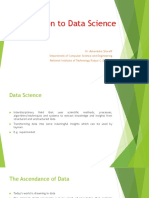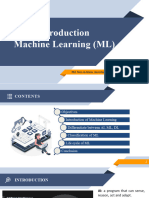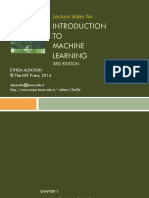0% found this document useful (0 votes)
132 views12 pagesEEL 6935 Data Analytics: Introduction To Data Science & Machine Learning
This document provides an introduction to a lecture on data science and machine learning. It defines data science as a highly interdisciplinary field that uses mathematics, computer science, engineering, and other areas. It also discusses what data scientists do, such as understanding data generation processes, modeling data using statistics and probability, and developing algorithms to learn from data and discover patterns. The document then defines machine learning as using algorithms to discover patterns in data and infer information about the data source. It provides examples of different machine learning techniques like supervised, unsupervised, and semi-supervised learning. Finally, it discusses concepts like model complexity, regularization, and cross validation that are important for machine learning.
Uploaded by
AlMuthanna NassarCopyright
© © All Rights Reserved
We take content rights seriously. If you suspect this is your content, claim it here.
Available Formats
Download as PDF, TXT or read online on Scribd
0% found this document useful (0 votes)
132 views12 pagesEEL 6935 Data Analytics: Introduction To Data Science & Machine Learning
This document provides an introduction to a lecture on data science and machine learning. It defines data science as a highly interdisciplinary field that uses mathematics, computer science, engineering, and other areas. It also discusses what data scientists do, such as understanding data generation processes, modeling data using statistics and probability, and developing algorithms to learn from data and discover patterns. The document then defines machine learning as using algorithms to discover patterns in data and infer information about the data source. It provides examples of different machine learning techniques like supervised, unsupervised, and semi-supervised learning. Finally, it discusses concepts like model complexity, regularization, and cross validation that are important for machine learning.
Uploaded by
AlMuthanna NassarCopyright
© © All Rights Reserved
We take content rights seriously. If you suspect this is your content, claim it here.
Available Formats
Download as PDF, TXT or read online on Scribd
/ 12






















































































